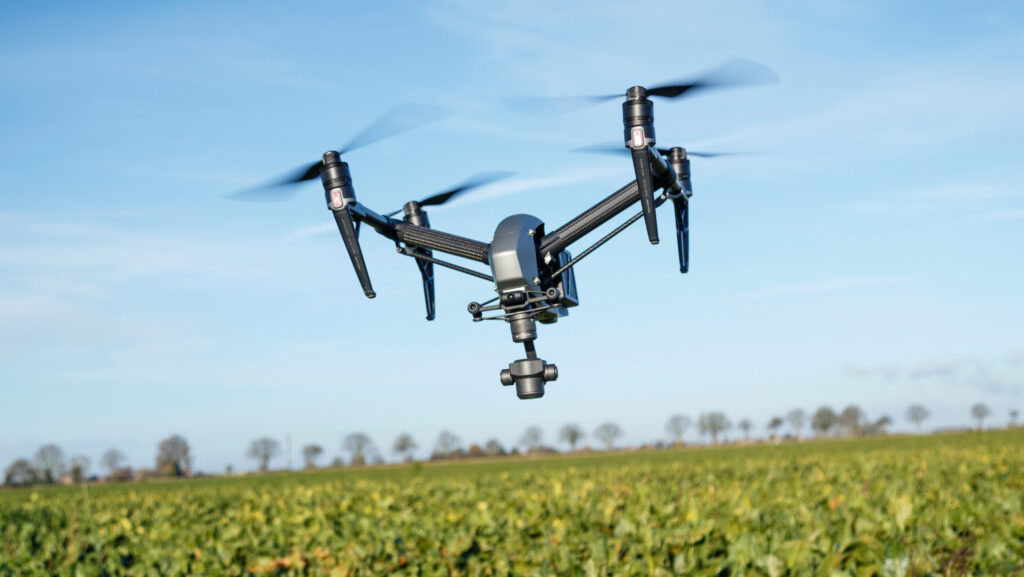Precision farming: Benefits, costs and developments
 © GNP
© GNP Practical pointers on new technology were the focus of a Transition Project event in our webinar series.
Precision farming techniques are already used across about 60% of UK farmland and the expert panel set out some of the tools available.
See more: How 3 farmers are building resilience into their businesses
Often the term is applied to satellite-guided arable machinery and equipment, which provide operations data to the driver to hone fieldwork.
But precision farming also covers weather data, pest and disease monitors and livestock production information.
On livestock farms, collars and tags hold information and can communicate with weigh crates and handheld readers, while animal health monitors can detect diseases earlier.
Expert panel
Transition Project editor and webinar host Johann Tasker was joined by three experts on precision farming to discuss how new technology can boost profitability, efficiency and productivity.
- Dr Trisha Toop, delivery director at the UK Agritech Centre
- Rupert Harlow, marketing manager for Yagro
- Max Dafforn, digital campaign manager with Bayer Crop Science
Rupert Harlow said that on arable units, real-time tracking of crops and pest monitors helped identify which fields were ahead or behind in the difficult growing conditions of 2024 and allowed growers to optimise inputs.
Using precision tools
With so many different options, research into precision farming can be bewildering, and it is difficult to know where to start.
Dr Trisha Toop said it was key to focus on the particular challenges the business was trying to solve.
There are so many precision tools and technologies that failing to identify the problems at the outset could lead to a scattergun approach and waste time and money.
Trisha added that farmers and growers should seek advice and tap into independent support.
Max Dafforn said it was vital to benchmark the business to establish a baseline.
“From that position you can measure how the technology is helping you to progress towards those targets,” he said.
Rupert agreed and added that producers must also monitor the financial returns on the investment.
“Then you can understand what value it’s contributing over time. If it’s not contributing positively, reassess the situation and try a different approach.”
Changing mindsets
Trisha also highlighted the importance of educating staff.
Precision farming needs a team-wide approach, and that must be instilled in staff from the outset.
She had visited farms where there had been some reticence towards new technology among staff, so the data collection had been patchy.
“So you must demonstrate the value and the aims, otherwise staff will feel they are just being asked to do more work without understanding why.”
Max pointed out that without staff buy-in, the processes required might not be understood and tasks left incomplete.
“Telematics from equipment needs collating carefully and organisation otherwise the data can get very messy, very quickly,” he said.
Rupert predicted that as technology improved, operating precision tools would become simpler, making it an easier sell to the team members.
“The technology will allow them to do other parts of the job better. A GPS system will allow the driver to follow tramlines accurately.
“They can then better monitor what the drill is doing and refine that operation, whereas they couldn’t before.”
Costs
Questions from the webinar audience highlighted concern over new technology costs.
Equipment cost can be prohibitive, especially for small-scale farmers who could perhaps see the most benefit.
Rupert suggested that some were taking a wait-and-see approach in the hope that technology would become cheaper in a few years.
“But if clear objectives and financial targets are set out now, it may be an investment that will still yield returns so the adopting farm could have a valuable head-start on competitors,” he noted.
Trisha said Agritech was pushing companies to bring prices down and pointed to financial support from Defra grants and other help from bodies such as Innovate UK.
Max said financial support was also available through government schemes such as the Sustainable Farming Incentive (SFI) in England.
“Targeted crop nutrition is encouraged and this can be better managed through precision technology so there is some extra financial reward already,” he said.
Key challenges and developments
Undoubtedly, artificial intelligence will play a big role. Max said a big challenge with precision tools is analysing and interpreting data. Data is only useful if it can be understood and applied effectively.
Too frequently different platforms don’t work together, and a farm may have all of its detailed mapping sitting on a USB stick on a shelf, he said.
AI-driven programmes could help to solve some of this by being able to interrogate the data better and setting it out for the farmer in a useable format, he said.
Trisha said consultants and farmers wanted to be able to use a single app to be able to see all the data in one place, and artificial intelligence advances could help.
She added that there were exciting developments for precision farming, which was moving from field and herd level monitoring to individual plants and animals.
For livestock, further developments in animal disease detection is a major goal, with efforts focused on developing faster pen-side detection for diseases.
This could ultimately improve welfare, cut antibiotic use and limit production setbacks.
